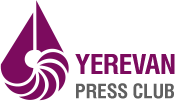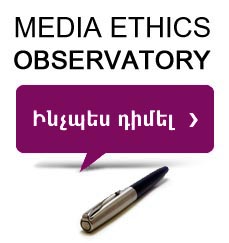Yerevan Press Club Report “Armenian Media in 1997”
A SOCIOLOGY LESSON
ALTHOUGH the annual reports of the YPC have a specific goal of summarizing the results of the previous year, today it is hard to discuss any issue without reflecting on the January-February events and the upcoming presidential elections.
Foreign media offered diverse interpretations of the shift of power in Armenia. It was called a “putsch”, a “velvet revolution”, a “victory of the war party over the party of peace”, etc. One of the Armenian papers added to the panic of those evaluations by mentioning “black colonels” and “gun-men” seeking control over the country…
Meanwhile, in my opinion, we are part of a more prosaic process. This year’s January-February events were a sociology lesson for us. The conflict of the country’s former leader, after all, was not against the “Karabagh party” or the “force structures.” The conflict was between the President and the society. This time, the society was not represented by a half million demonstrators on the Freedom Square, but rather by a small group of people from the power elite. True, some of our notorious colleagues were imaginative enough to make the word “fascism” trendy in the 1996 and 1997 fall-winter seasons – by slapping it on anybody who did not share the ex-President’s point of view. But none of the “fascist” or “colored” colonels would have the courage to oppose the head of the country if it were not for their sense of a firm, yet maybe not so loud, support by the prevailing public opinion. In the same manner, a “pigeon of peace” attacked by the “hawks” would not ignore its right to ask for public support if it deserved it.
And we must say that the economically, politically and psychologically oppressed Armenian press did act as a mature civic institute. To a certain degree, it was the media that reflected the moods of the people, inspiring some with the idea of a righteous action and giving others a feeling of being doomed.
HOWEVER, this does not mean that Armenia has developed a society that possesses the mechanisms of democracy and the media became capable of overturning unwanted and inefficient leaders. We must not forget that the mechanism of putting public opinion and mood into practice has worked in the Karabagh issue, which has almost become the main element of the thinking of a contemporary Armenian. Over that stone have already stumbled and fallen from the Olympus of politics, the leaders of the communist era. Today their successors have followed them.
In any other case, neither the society, nor its “watchdogs” – journalists – could even come close to the levers of power which could defend their interests. And “the well-known organs of power” capable of “laying claims” (quoted from the ex-President’s resignation address – Ed.) against the President were not revealing themselves in any way, although there were more than enough reasons: the cynical violation of the people’s freely expressed will during the parliamentary (1995), and presidential (1996) elections; the strange privatization from which nothing was gained neither by the vast majority of the population nor by the state treasury… Therefore, it would be an early judgment to say that the “fourth estate” (the power of public opinion) and its main instrument (the media) are established in Armenia. (I will allow myself to repeat and stress one more time that while the media are an instrument of the fourth branch of power, the presence of this instrument does not yet mean the presence of the “fourth estate”. We may talk about it as an accomplished fact only when media (print and electronic) are able to supply the public, intensively and constantly, with full and timely information; to reflect public opinion adequately, observing the public interest.)
Of course, the process of privatization and unfair elections, partially covered by the media, played a role in the recent fiasco of the President and his team. The absence of political credit has made it more difficult to carry out their unpopular political course. But if it weren’t for the Karabagh issue (as in 1988 as well), our society would remain imprisoned by the stagnation without finding a way out of it.
EVEN now, we do not yet possess an efficient tool for supporting the public interest. Therefore, the lesson that has begun is extremely important for the emerging institutions of a civic society, including the media. The leadership will never change its expansionist nature voluntarily. And it will never deny itself the pleasure of capturing the same areas of freedom that seem available today but may disappear tomorrow. Then we will have only one thing to expect: a new sociology lesson…
LISTENING CAREFULLY AND DOING THE OPPOSITE
WHETHER by accident or not, almost at the same time as the September press conference of Levon Ter-Petrossian in which he expressed his vision of the solution of the Karabagh issue, the Yerevan Office of the United Nations Department of Public Information invited Armenian media professionals to take part in a competition in preventive journalism. The YPC Newsletter (October 1997) predicted that competition for the prize would be significant: the President’s Karabagh plan had inspired numerous publications with a single motif: “we will not let anyone sell Karabagh.” History will show who was right and who was wrong in the discussion that followed, but for now, preventive journalism has defeated the leadership. Even Ter-Petrossian’s special tactics expressed in the phrase “we discussed it here and I decided…” did not help him. (In other words, he was inviting a discussion over an issue that he had already decided for himself.)
Formerly, these tactics were unbeatable. Mimicking democrats who are open to any sort of debate, our leaders would often invite the public and the media to discuss any issue. Those invited were flattered by the mere fact of being invited, and being part of the debate, and sometimes didn’t even notice that their opinions had not in the least affected the decisions. This form of intercourse with the society worked flawlessly up to a certain point in time. And not only on major issues of public interest discussed in the media, but also applied to internal problems relating to the functioning of the media.
At the end of 1996, media representatives were invited by the then Prime Minister to take part in the decision about the fate of the Ministry of Information that was supposed to be eliminated, as well as on the state-owned media and state property related to their activity (the Press House, the “Parberakan” publishing house, the “Haymamoul” press distribution agency…) The journalists reacted by submitting a detailed program of denationalization. As a result, none of the proposals was accepted. The National Television, Radio, the Armenpress news agency, and “Haymamoul” were initially handed over to the Department of Information and Publications, but later became joint-stock companies with 100% state ownership. All these upheavals drained considerable funds from the budget, which the press lacked so desperately; the scant national information potential was spread even thinner.
The status of the official press – the “Hayastani Hanrapetutyun” and “Respublica Armenia” dailies – remained undefined. But as before, they were under full control of the office of the National Assembly (until recently, under the President’s office, as well). The formal founders, the staff of the newspapers and the parliament (i.e. the deputies), had no rights to own any publications.
The “Tigran Mets” (the former “Parberakan”) printing house was partially privatized, but none of the newspapers got any of the shares. The 34% of the property that remained in the hands of the state was a rather strong lever of political pressure. A paradoxical situation was created, or rather cemented, in place: the intellectual and technical components of the print media remained separate spheres of the news industry. (This is almost the same as if a design office developed models of Mercedes and BMW and then gave the order for line production to individual independent factories. It is not hard to imagine how much would that lift the prices and lower the quality of the cars.) The printing house, being the monopolist, dictates conditions to those whom it is designed to serve. By the way, this is also how “Haymamoul” works, allowing itself to renege on its financial obligations towards the newspapers. The representatives of associated “newspaper” businesses are likely to be perfectly sure that the press exists only in order to provide them with jobs and large incomes.
Even the Press House which roofs a number of editorial offices is not owned by them. As a great favor, the press is given the right to use its premises for free. The newspaper offices only pay for the energy and other utilities. There are no government decrees to confirm this situation, and the favor can turn into anger any moment: in this case, to cosmic prices for each square meter. And then the press will have to give its shelter to commercial firms. The Press House has already had such a period in its lifetime.
The press becomes free when it establishes itself as a self-sufficient sphere of business. The Armenian print press remains alienated, estranged from any property and basic production facilities. Probably, this is the only area of business activity that did not gain anything from the privatization of the former state property.
It is apparent that this is not only a matter of economics. This is seen in the example of television. The ownership of privatized state TV channels does not include broadcasting equipment which remains under the Ministry of Communications. In fact, full state control is guaranteed over the outcome of television product of the two biggest television channels. Newspaper publishing can also be taken under control at any moment. From last year’s experience we know how effectively unwanted information can be prevented from being disseminated. One only needs to recall how the printing house blocked delivery of the newspaper “Haykakan Zhamanak” to its readers in one day.
Last spring, a Draft Law “On Television and Radio” prepared by the parliamentary Standing Committee on Science, Education, Culture and Youth Issues was presented for public discussion. Both at that time and later, journalists were asked to participate actively in the creation of the Draft Law. The offer was taken up. Representatives of media not only made a number of comments and suggestions, but also developed an alternative version of the draft law. The basic objections to the official draft could be summarized as complaints that it did not differentiate between the scopes of state and private broadcasting. There was no effective mechanism for public control over the activity of TV and radio companies funded by taxpayer money. The financial and technical potential of the independent broadcasters was not taken into consideration, either. And finally, it was suggested that the legal environment be prepared prior to the adoption of this specific law. That is, to wait for a new Civil Code, to renovate the hopelessly outdated Law “On the Press and Other Media” which is key for the media sphere.
But apparently in this case, too, the opinions of professionals were needed only in order to listen to carefully, before doing the opposite… The discussion of the basic legislation was postponed each time, whereas the Draft Law “On Television and Radio” was consistently moved from the agenda of one session of the parliament to another. And the further it goes, the less it meets the requirements of the journalistic community. In the last version, the mechanisms of public control over state broadcasting were excluded completely.
But the most surprising thing is that the law-making process in the area of broadcasting, and the reforms of state TV and radio carried out in practice, totally contradict each other. The status of the National Television and the National Radio established by the Government (joint-stock companies with 100% state ownership) does not match with what the parliamentary Committee sets out in its draft broadcasting law. But one thing that brings those approaches – state and parliamentary – together, is their radical difference from the journalist proposals, which were based on the requirement that electronic media should maximally serve the public.
SAVING THE PRESS IS UP TO THE PRESS
THE above examples were given to show that no one will pave the way to freedom for the Armenian media. Protecting their interests, the media should never relax. The alertness, principals and consistency that the media showed during the last political crisis should be employed to protect their own rights, or else the principle of “listening carefully and doing the opposite” will remain the dominating mode of intercourse between the media and the Government. If you become euphoric each time “they” deign to listen to you and your problems, you risk losing the initiative. The principle of preventive journalism is good not only while covering major political issues, but also during a continuous dialogue with the leadership of the country, aimed at gaining new areas of freedom.
Since December 1997, the Armenian press, with support from journalist associations, demonstrated its ability to coalesce around shared problems. For the first time several media outlets went on a warning strike and forced the Government to make serious commitments: to reimburse value-added taxes, to make the utility tariffs for media outlets equal to those established for state-subsidized enterprises, and, as said above, to provide gratuitously the premises within the Press House… But as soon the media relaxed, some of the promises evaporated. A strike, as an extreme measure, can be effective for “shaking up”. But if only a single issue of a newspaper fails to come out, the reader gets less. Therefore, it is much more important to understand the corporate interest (and sometimes compromising immediate private interests); to be consistent (as opposed to vacillating from one action to another), insistent and unified – thus establishing the rule of the “fourth estate”.
THE establishment of a free, responsible, professional press happens when the efforts of journalists are directed not only outwards, but also inwards: when journalists are not only unbinding themselves, but also getting used to productive professional work and proper manners. In this sense, the Armenian media have as many problems as in the area of defending their own rights and interests. Journalistic and media behavior in our country is far from meeting the traditional professional and ethical standards. I would like to mention only one or two deeply rooted vices. First, journalists’ feuding, back-biting and hatred towards each other are sometimes carried out in the pages of newspapers and on the air. Without pompous phrases about professional solidarity, I would like to point out that mutual rumor-mongering is also disrespectful to the audience who neither wants nor has to know about the internal journalistic family squabbles. People have other things to worry about. The second vice is anonymity, open and hidden. There are anonymously penned articles everywhere. Sometimes articles are signed with names that say nothing about the author. From year to year, the pages of our newspapers have been sheltering the “mythical” analysts Yevgeniy Kourghinian and Gevork Hovsepian who have enough courage to raise crucial national issues, but are not ready to take off their masks. Recently, they were joined by a Russian fellow, someone Alexey Pashkov, the “author” of the infamous publication in the “Nezavisimaya Gazeta” daily that raised the issue of the “threat of fascism” in Armenia. It is a shame for both the journalists who hide behind made-up names, and the media that publish anonymous articles. The international journalist codes require that the author be identified even if he/she prefers to sign in initials, in a pseudonym, or somehow else. Otherwise, the views expressed are considered to be those of the editor. Whereas in the examples brought from the Armenian press, neither the authors, nor the media are willing to take the responsibility for what they have written. How is that better than anonymous writing?
ELECTIONS OF THE PRESIDENT AND THE CHOICE OF MEDIA
ARMENIAN media are living through another election campaign. The entire country is hoping that it will finally have free and fair elections. But the mere fact that the elections will be held in this manner is not enough. It is necessary that people start to believe in the fairness of the elections. But humankind has not yet invented a way of winning people’s trust in the outcome of elections other than by informing the public immediately about the results from each precinct. The viewer (listener, reader) must feel his/her immediate participation on the entire territory of the country. Any delay in the delivery of information can cause doubts about falsification. Especially considering our previous sad experience. The chairman of the Central Electoral Commission, Khachatour Bezirjian, has promised that the incoming preliminary data will be posted immediately on the Internet. I hope that anyone can access them and no one has reasons for doubt that the electoral commissions are “factories” for producing the “needed President.”
Journalists, too, must make their choice and decide if they are ready to follow the principles of professionalism and journalistic ethics, which is especially important these days. The Board of the Media Association has prepared a Memorandum which includes the basic principles of elections coverage (YPC Newsletter, February 1998). Respect for these rules would serve as evidence of maturity for each individual media outlet and the entire media family of Armenia.












